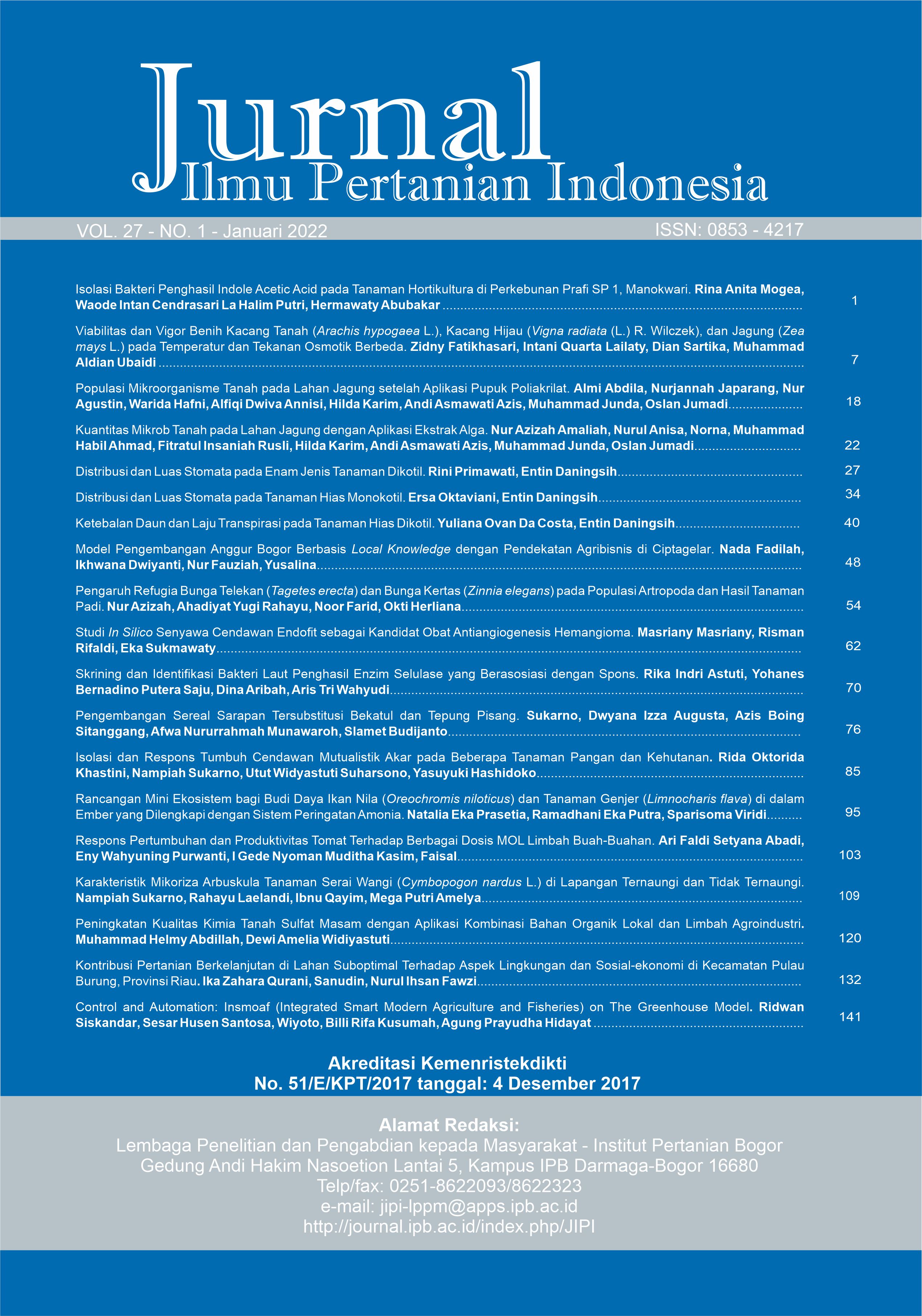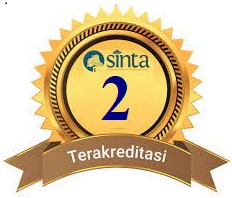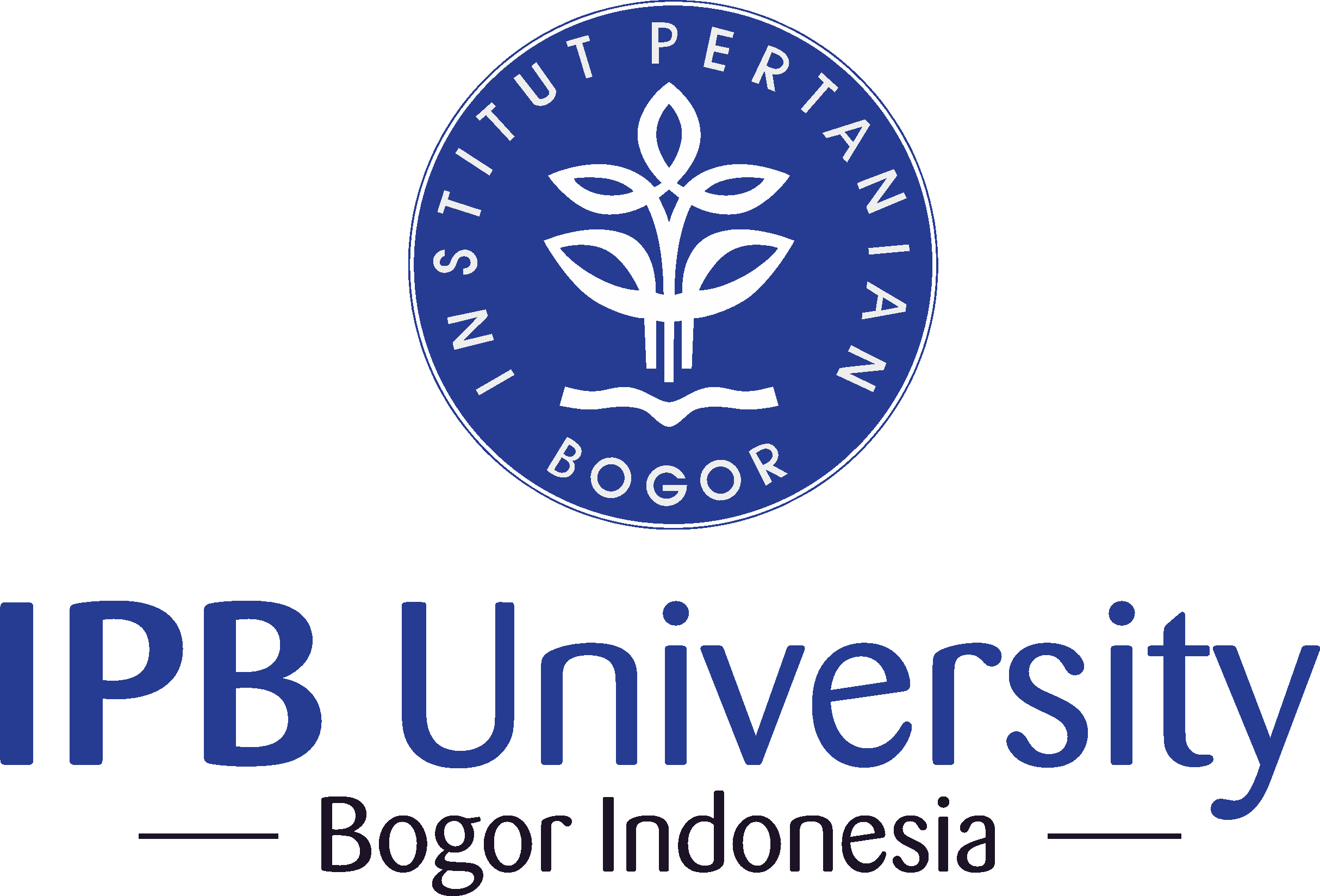Respons Pertumbuhan dan Produktivitas Tomat Terhadap Berbagai Dosis MOL Limbah Buah-Buahan
Abstract
The purpose of this study was to determine the response of growth and productivity of tomato plants to the application of various doses of local microorganisms obtained from fruit waste. The study used a completely randomized design with 4 treatments and 6 replications. Observation parameters consisted of plant height (cm), number of leaves (strands), productivity (grams), and number of fruits. The best application results were at a dose of 30 ml per plant. The parameter of plant height at a dose of 30 ml produced an average of 114.83 cm, the parameter of the number of leaves produced an average of 190.83 strands, then the parameter of the number of fruits produced an average of 7.5 pieces, and the last parameter was the average fruit weight -an average of 446.16 grams. MOL affects the growth and productivity of tomato plants because it contains macro and micro nutrients and contains various microbes that are beneficial to plants.
Keywords: dosage, MOL application, tomato growth, tomato productivity
Downloads
References
[BPS] Badan Pusat Statistik 2020, Produksi Tanaman Sayuran Menurut Kecamatan dan Jenis Tanaman di Kota Batu, 2018 dan 2019, Kota Batu.
Bargumono, Maryama. 2020. Dasar-Dasar Teknik Budidaya Tanaman. Yogyakarta (ID): Gosyen Publishing.
Broto RTD, Wisnu, Fahmi A, Wilis A, Setyati, Karinta E, Detian IP. 2019. Pembuatan Mikroorganisme Lokal Dengan Bahan Baku Bonggol Pisang ( MOL BOPI ) Sebagai Alternatif Pestisida Organik dan Pengganti EM4 di Desa Bumen ,Kecamatan Sumowono, Kabupaten Semarang. Seminar Nasional Kolaborasi Pengabdian Kepada Masyarakat UNDIP-UNNES. 5. Solo (ID).
Budiyani, Ni Komang, Ni Nengah S, Ni Wayan SS. 2016. Analisis Kualitas Larutan Mikroorganisme Lokal (MOL) Bonggol Pisang. E-Jurnal Agroekoteknologi Tropika. 5(1).
Bui, Florentina, Maria Afnita Lelang & R.I.C.O. Taolin. 2015. Pengaruh Komposisi Media Tanam dan Ukuran Polybag Terhadap Pertumbuhan dan Hasil Tomat (Licopercicum escelentum, Mill). Jurnal Konversi Lahan Kering. 1(1): 17. https:// doi.org/10.32938/sc.v1i01.1
Cahyono B. 2003. Tomat Budidaya dan Analisis Usaha Tani. Yogyakarta (ID): Kanisius.
Hadi, Roni A. 2019. Pemanfaatan Mol (Mikroorganisme Lokal) Dari Materi Yang Tersedia Di Sekitar Lingkungan. Agroscience. 9(1). https:// doi.org/10.35194/agsci.v9i1.637
Hapsari, Risda, Didik I, Erlina A. 2017. Pengaruh Pengurangan Jumlah Cabang dan Jumlah Buah Terhadap Pertumbuhan dan Hasil Tomat (Solanum Lycopersicum L.). Vegetalika. 6(3). https://doi.org/ 10.22146/veg.28016
Herlinda, Siti MD, Utama Y, Pujiastuti, Suwandi. 2006. Kerapatan dan Viabilitas Spora Beauveria bassiana (Bals.) Akibat Sub Kultur dan Pengayaan Media Serta Virulensinya terhadap Larva Plutella xylostella (Linn.) Jurnal Hama dan Penyakit Tumbuhan Tropika. 6(2). https://doi.org/10.23960/ j.hptt.2670-78
Irfan M. 2014. Isolasi Dan Enumerasi Bakteri Tanah Gambut Di Perkebunan Kelapa Sawit Pt. Tambang Hijau Kecamatan Tambang Kabupaten Kampar. Jurnal Agroteknologi. 5(1): 18.
Istamar. 2000. Biologi 2000 SMU jilid B. Jakarta (ID): Erlangga.
Jeksen, Julianus, Charly M. 2018. Pengaruh Sumber Bahan Organik Yang Berbeda Terhadap Kualitas Pembuatan Mikroorganisme Lokal (Mol). AGRICA, Journal on Agricultural Sciences. 11(1): 6072. https://doi.org/10.37478/agr.v11i1.23
Kurniawan A. 2018. Produksi Mol (Mikroorganisme Lokal) Dengan Pemanfaatan Bahan-Bahan Organik Yang Ada Di Sekitar. Jurnal Hexagro. 2(2). https://doi.org/10.36423/hexagro.v2i2.130
Musnamar HS. 2007. Pupuk Organik Cair dan Padat, Pembuatan, Aplikasi. Jakarta (ID): Penebar Swadaya.
Panjaitan, Fanny J, Lele OK, Taopan RA, Yohanes K. 2020. Aplikasi Beberapa Jenis Dan Dosis Mikroorganisme Lokal Limbah Tomat Dan Sayuran Dalam Meningkatkan Pertumbuhan Dan Hasil Tanaman Cabai (Capsicum Annum L.). Agrotekma. 5(1).
Purwasasmita M, Kunia K. 2009. Mikroorganisme lokal sebagai pemicu siklus kehidupan dalam bioreaktor tanaman. Seminar Nasional Teknik Kimia Indonesia- SNTKI 2009. Bandung (ID).
Raras, Noorvita, Abdul H, Burhanuddin L. 2018. Pengaruh Mikroorganisme Lokal Buah-Buahan Terhadap Pertumbuhan Dan Hasil Tanaman Selada (Lactuca Sativa L.). Agrotekbis. 6(1): 127135.
Rinaldi M. 2019. Panduan lengkap & praktis budi daya tomat yang paling menguntungkan. Jakarta (ID): Garuda Pustaka.
Sembiring, Melda Y, Lilik S, Yogi S. 2017. Pengaruh Dosis Pupuk Urin Kelinci Terhadap Pertumbuhan Dan Hasil Beberapa Varietas Tomat. Jurnal Produksi Tanaman. 5(1).
Septirosya, Tiara, Ratih HP, Tahrir A. 2019. Aplikasi Pupuk Organik Cair Lamtoro Pada Pertumbuhan Dan Hasil Tanaman Tomat. AGROSCRIPT, Journal of Applied Agricultural Sciences. 1(1): 18. https://doi.org/10.36423/agroscript.v1i1.185
Sugiyono. 2012. Metode Penelitian Kuantitatif, Kualitatif, dan R&D. Bandung (ID): Alfabeta.
Syukur, Makmur, Sitompul, Bambang, Guritno. 1995. Analisis Pertumbuhan Tanaman. Yogyakarta (ID): Gadjah Mada University Press. https://doi.org/ 10.19109/Biota.v7i1.7010
Yuliana M. 2021. The Effect of Local Microorganism (Mol) as Liquid Organic Fertilizer to the Growth of Ipomea reptans Poir. Jurnal Biota. 7(1): 5156.
This journal is published under the terms of the Creative Commons Attribution-NonCommercial 4.0 International License. Authors who publish with this journal agree to the following terms: Authors retain copyright and grant the journal right of first publication with the work simultaneously licensed under a Creative Commons Attribution-NonCommercial 4.0 International License. Attribution — You must give appropriate credit, provide a link to the license, and indicate if changes were made. You may do so in any reasonable manner, but not in any way that suggests the licensor endorses you or your use. NonCommercial — You may not use the material for commercial purposes.






















